Global supply chains are incredibly complex and vulnerable to disruption. Artificial Intelligence in Supply Chain Management is emerging as the critical tool to bring visibility, efficiency, and resilience to this chaos. From predicting demand to optimizing delivery routes, here’s how AI is revolutionizing logistics and supply chain operations.

1. Demand Forecasting and Inventory Optimization
The Problem: Traditional forecasting often relies on outdated models, leading to overstocking (wasting capital) or understocking (missing sales and frustrating customers).
The AI Solution: AI algorithms analyze historical sales, seasonality, market trends, weather forecasts, and even social media sentiment to predict demand with far greater accuracy.
Result: Companies can maintain optimal inventory levels, reduce carrying costs, and minimize stockouts. This lesson was reinforced by recent global supply chain crises.
2. Smarter Warehousing and Robotics
The Problem: Manual picking and packing in warehouses is time-consuming and error-prone.
The AI Solution: AI-powered robots and vision systems identify, retrieve, and sort items while optimizing routes. According to Gartner, this automation drastically improves warehouse efficiency.

Result: Faster throughput, reduced errors, and cost savings that enable same-day and next-day deliveries.
3. Predictive Maintenance in Logistics
The Problem: Breakdowns in trucks, ships, or machinery can stall entire supply chains.
The AI Solution: IoT sensors track vibration, temperature, and performance data. AI predicts when parts will fail so maintenance happens proactively.
Result: Less downtime, lower repair costs, and extended equipment lifespan.
4. Optimized and Autonomous Transportation
The Problem: Inefficient routing and empty return trips waste fuel and money.
The AI Solution: Logistics platforms like Flexport and FourKites optimize routes using traffic, weather, and fuel data. They also reduce “deadheading” by matching cargo with available capacity.
Result: Faster delivery, reduced emissions, and lower costs.

5. Visibility and Risk Management in AI Supply Chains
The Problem: Companies often lose visibility once goods leave the factory.
The AI Solution: End-to-end tracking with GPS, IoT sensors, and real-time updates. AI also analyzes global news and events (storms, strikes, political unrest) to suggest alternatives before disruptions occur.
Result: Greater agility and resilience in the supply chain.
6. Supplier Management with AI Insights
The Problem: Selecting reliable suppliers can be difficult with limited data.
The AI Solution: AI tools analyze supplier performance, delivery rates, financial health, and quality scores to rank and recommend the best partners.
The Bottom Line: AI Powers Resilient Supply Chains
The modern supply chain is too complex for humans to manage alone. Artificial Intelligence in Supply Chain Management provides the analytical power to predict, optimize, and respond in real time. Businesses that embrace AI are building supply chains that are efficient, cost-effective, and resilient in an unpredictable world.
Explore how AI is transforming manufacturing to see its impact across the full value chain.
